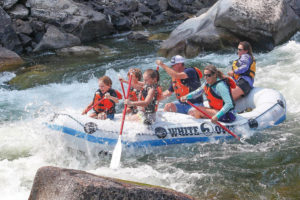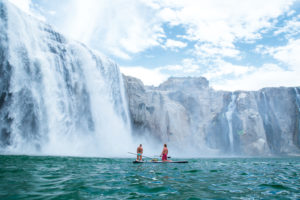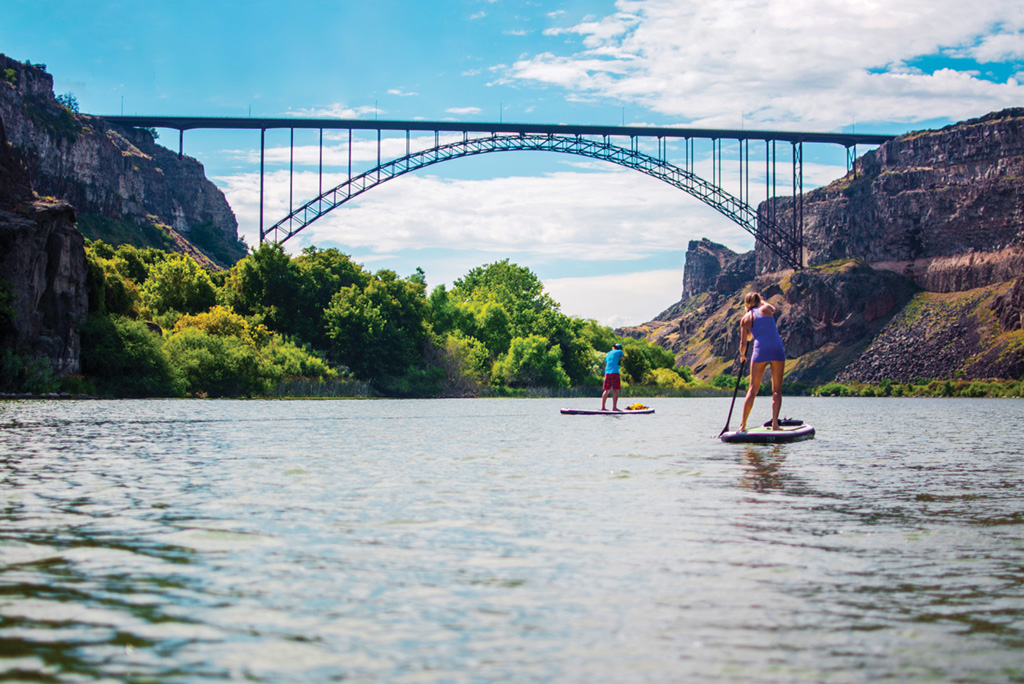Nothing says summer quite like floating down a river. And when the weather is hot and the days are long, the best way to get out there is to go with the flow and sink into “river time.”
There are no shortages of destination day trips around the Wood River Valley. From the Salmon River outside of Stanley, to the Snake River near Hagerman, to the Payette River north of Boise, options are extensive. There is a range from relaxing floats to action-packed whitewater and everything in between.
Lila Fenn and her siblings Sam and Benjamin have become accustomed to summers on the river. Daughter of Nancy and Doug Fenn, owners of White Otter Outdoor Adventures, 18-year-old Lila describes, “The river is our happy place. You feel totally free in the water, and it’s always a place of play for us.” When asked why he enjoys the river, Lila’s younger brother Benjamin summed it up pretty well: “Duh, it’s just fun.”
Rivers are rated on a scale of Class I to Class V, with Class I being a flat current and Class V being highly risky with any combination of violent holes, waves and drops. On easier sections, many enjoy tubing and standup paddleboarding, and on all sections, you can pick your relaxation or adrenaline fix in a raft or inflatable or hardshell kayak.
 Salmon River
Salmon River
Many different outfitters operate guided trips on the “day stretch” of the Salmon and on the weeklong “Main Salmon” stretch or remote Middle Fork of the Salmon River wilderness. The day stretch is about 10 miles of Class II and Class III whitewater, popular for family rafting trips.
Rivers throughout the region are rich in history. The Salmon River, also known as the “River of No Return,” is one of the largest rivers in the United States that flows unobstructed by dams on its course from the headwaters near Galena Summit to the confluence with the Snake River over 400 miles downstream. The Salmon River got its daunting nickname from early pioneers in the area trying their luck for gold mining. While they were able to navigate downstream on large sweep boats, they could find no easy way back up—thus, the “River of No Return” nomiker. Before being forced out by settlers, the Nez Perce tribe called the Salmon River, or “Tamánma,” home, and relied heavily on the abundant salmon runs that once flooded the river annually in the time before the dams were constructed on the Snake and Columbia rivers.

Paddleboarding at Shoshone Falls on the Snake River (the Niagra of the West)!
Snake River
For those looking for some good, relaxed paddling, the Hagerman stretch of the Snake River outside of Twin Falls offers a scenic paradise. At Backwoods Mountain Sports in Ketchum, you can rent SUPs and inflatable kayaks to paddle around Ritter Island or down Billingsley Creek at Thousand Springs State Park. A second section provides a fantastic summer cool-off option on the Snake, which is to paddle from Centennial Park upstream to Pillar Falls, a two-mile journey that takes about three hours round trip.
If you reach Pillar Falls and are up for an extra adventure, you can continue heading another 1.5 miles upstream to the iconic Shoshone Falls. At 212 feet, the falls are considered the “Niagara of the West.” They offer the perfect backdrop to stop, enjoy a well-deserved snack and snap some photos before making the four-mile trek back downstream. Please keep in mind that, while spectacular, you should view this geological wonder from a safe distance due to the turbulence of the water and the strong hydraulics beneath the falls. If you are on a paddleboard, the currents from the river and crashing falls get more intense, so kneel or sit down as necessary.
Big Wood River
Annie DeAngelo, a budding pioneer of standup paddleboarding adventures in Idaho, says, “Getting into SUP-ing is so fun. It’s perfect for our area because every class of water gets bumped up a class or two when you are on a SUP.” In the Wood River Valley, standup paddleboarding in the Hulen Meadows pond is a great place to start. Annie, an adrenaline seeker, can often be found on micro-stretches of the Big Wood River. Make sure you “know before you go.” The Big Wood, or “B Dub” as it is known to the locals, usually holds true to its name and is riddled with wood accumulation throughout and after spring runoff, which can be dangerous to paddlers.
Wood is one of the many hazards to be cautious of when navigating rivers. Logs and other obstructions that may let water, but not a swimmer, through, are known as “strainers’’ and should be avoided. River recreators also stay cautious of foot entrapment by avoiding standing up in river current unless the water is below your knees. Knowing how to “read” water and pick out holes, waves, eddies and safe lines of navigation through rapids is crucial. If you are new to rivers, taking a Swiftwater Rescue Course is highly recommended to familiarize yourself with the basics of river safety.
More options
The list is endless for floats to enjoy and safely explore this summer. Boise River from Barber Park and Ann Morrison Park is a popular stretch for tubers, and the lakes north of Galena Summit also offer a pleasant cruise on a hot July day. Remember to always be courteous and respectful of fishermen or other boaters or tubers. Getting out on the water anywhere this summer is a great way to plug into the innate joy of being together. Doug Fenn, Lila’s dad, noted, “The river keeps our community together. What the river gives us is this opportunity to connect no matter what. That’s the power of the river.”
Gear Checklist
Before you head out on your next paddling adventure, make sure you pack the following:
- Life vest
- First-aid kit
- Water bottle
- Sunglasses
- Hat
- Sunscreen
- Waterproof case for phone
- Dry bag
- Water shoes/Sandals
- Swimsuit
- Rain jacket
- Towel
- Dry clothes in vehicle
- Mapping app
- Weather app


